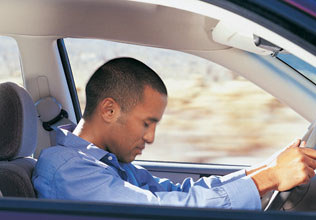Sleeping at the wheel can prove fatal
 Munich - Driving when drowsy is a feeling that every motorist knows. The danger is greatest on long stretches of motorway when concentration drops and the urge for a rest grows stronger.
Munich - Driving when drowsy is a feeling that every motorist knows. The danger is greatest on long stretches of motorway when concentration drops and the urge for a rest grows stronger.
This can often lead to a driver falling asleep at the wheel - a situation which can have fatal consequences. Every year, numerous road accidents are caused by tiredness.
It has become such a problem that car manufacturers are developing new technology that alerts drivers when they are in danger of nodding off behind the wheel.
Falling asleep while driving is to blame for one in four fatal accidents in Germany, according to a study by the Institute of German Insurance Agents.
The danger is particularly acute when driving on German autobahns, where long, straight stretches coupled with the monotony of the landscape increases the risk of drowsiness.
Experts like Volker Hargutt, a psychologist at Wuerzburg University's Centre for Transportation Sciences, believes that 20-25 per cent of all serious accidents are caused by fatigue.
"Fatigue is an important factor in road accidents, but the figure could be higher than thought because there are no reliable statistics available," says Werner Sauerhoefer of the German Road Safety Council.
This is not surprising as you will rarely find a driver who'll admit to nodding off at the wheel.
Car manufacturers are already experimenting on ways to combat inattention and drowsiness that motorists sometimes experience when on the road. One of the pioneers in this field is Swedish manufacturer Volvo, which has developed a Driver Alert Control (DAC).
"Basically it involves a camera that monitors what is going on from the front of the vehicle," says Olaf Meidt, a spokesman for Volvo Germany.
The camera records the driving style of the person behind the wheel. If he is alert and concentrating, he usually drives in a clear and straightforward manner. This changes once he becomes tired or distracted.
At the beginning of his journey, the driver has a "full account" that is shown on a digital strip diagram located on the dashboard. If he drives in a careless manner, the strip gets smaller until the DAC decides enough is enough.
Once this happens, the system gives off an acoustic warning and the symbol of a coffee cup appears on the dashboard diagram. "A coffee cup is an internationally accepted symbol for a rest," says Meidt.
A similar idea, although in a different form, is offered by the Driver Monitoring System that Toyota has introduced in its luxury Lexus LS models.
"It takes the form of an infrared camera located in the steering column," says Karsten Rehmann, a spokesman for Lexus in the city of Cologne.
The camera initially monitors the facial position of the alert driver and takes note if he fails to look straight ahead at the road for a given period of them.
Once this happens, the system makes the car brake slightly in order to jolt the driver out of his reverie.
Mercedes plans to introduce similar technology called Attention Assist in its new S and E class models that roll off the production lines in 2009.
The system uses a sensor to draw up an individual profile of the driver during the first few minutes of his journey. If the driving style changes owing to fatigue or distraction, the system lets the driver know by means of an acoustic signal.
A message also flashes up on the dashboard reading, "ATTENTION ASSIST - Pause!"
For those who cannot afford a pricey car with fatigue warning devices, there is also the good old traditional method of recognizing the onset of drowsiness.
"Burning eyebrows, the feeling you have to rub your eyes or yawning are typical symptoms of tiredness," says Almut Schoenermarck, a doctor who works with Germany's biggest motoring club, the ADAC.
Other indicators are shivers or failure to remember the last few kilometres of the journey. When this happens, it is clear the driver is tired and should take a rest. (dpa)